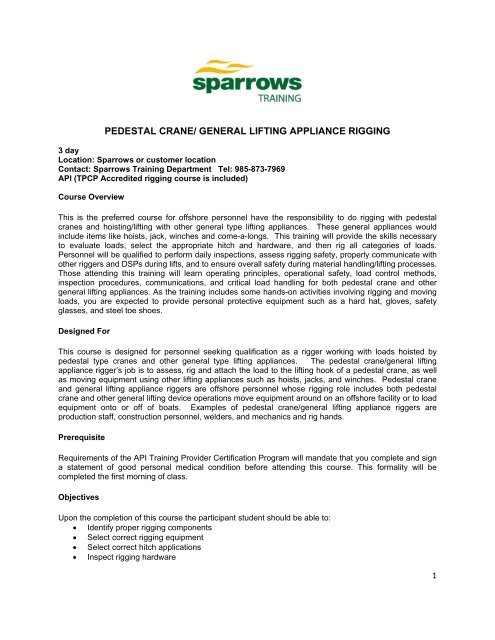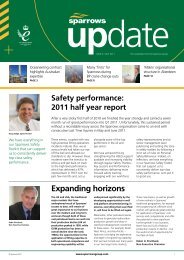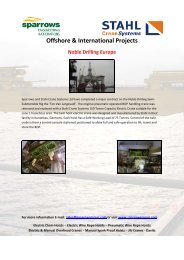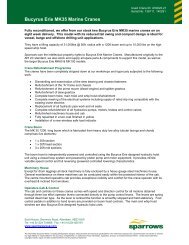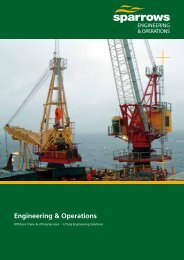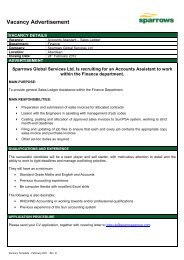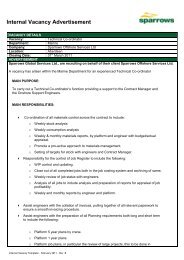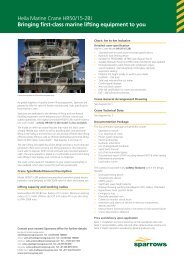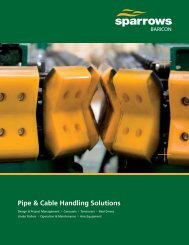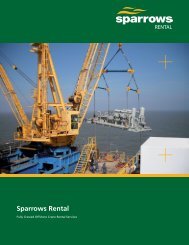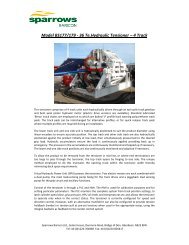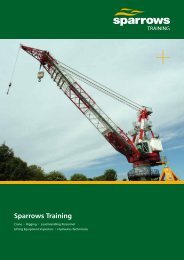pedestal crane/ general lifting appliance rigging - Sparrows
pedestal crane/ general lifting appliance rigging - Sparrows
pedestal crane/ general lifting appliance rigging - Sparrows
You also want an ePaper? Increase the reach of your titles
YUMPU automatically turns print PDFs into web optimized ePapers that Google loves.
PEDESTAL CRANE/ GENERAL LIFTING APPLIANCE RIGGING<br />
3 day<br />
Location: <strong>Sparrows</strong> or customer location<br />
Contact: <strong>Sparrows</strong> Training Department Tel: 985-873-7969<br />
API (TPCP Accredited <strong>rigging</strong> course is included)<br />
Course Overview<br />
This is the preferred course for offshore personnel have the responsibility to do <strong>rigging</strong> with <strong>pedestal</strong><br />
<strong>crane</strong>s and hoisting/<strong>lifting</strong> with other <strong>general</strong> type <strong>lifting</strong> <strong>appliance</strong>s. These <strong>general</strong> <strong>appliance</strong>s would<br />
include items like hoists, jack, winches and come-a-longs. This training will provide the skills necessary<br />
to evaluate loads, select the appropriate hitch and hardware, and then rig all categories of loads.<br />
Personnel will be qualified to perform daily inspections, assess <strong>rigging</strong> safety, properly communicate with<br />
other riggers and DSPs during lifts, and to ensure overall safety during material handling/<strong>lifting</strong> processes.<br />
Those attending this training will learn operating principles, operational safety, load control methods,<br />
inspection procedures, communications, and critical load handling for both <strong>pedestal</strong> <strong>crane</strong> and other<br />
<strong>general</strong> <strong>lifting</strong> <strong>appliance</strong>s. As the training includes some hands-on activities involving <strong>rigging</strong> and moving<br />
loads, you are expected to provide personal protective equipment such as a hard hat, gloves, safety<br />
glasses, and steel toe shoes.<br />
Designed For<br />
This course is designed for personnel seeking qualification as a rigger working with loads hoisted by<br />
<strong>pedestal</strong> type <strong>crane</strong>s and other <strong>general</strong> type <strong>lifting</strong> <strong>appliance</strong>s. The <strong>pedestal</strong> <strong>crane</strong>/<strong>general</strong> <strong>lifting</strong><br />
<strong>appliance</strong> rigger’s job is to assess, rig and attach the load to the <strong>lifting</strong> hook of a <strong>pedestal</strong> <strong>crane</strong>, as well<br />
as moving equipment using other <strong>lifting</strong> <strong>appliance</strong>s such as hoists, jacks, and winches. Pedestal <strong>crane</strong><br />
and <strong>general</strong> <strong>lifting</strong> <strong>appliance</strong> riggers are offshore personnel whose <strong>rigging</strong> role includes both <strong>pedestal</strong><br />
<strong>crane</strong> and other <strong>general</strong> <strong>lifting</strong> device operations move equipment around on an offshore facility or to load<br />
equipment onto or off of boats. Examples of <strong>pedestal</strong> <strong>crane</strong>/<strong>general</strong> <strong>lifting</strong> <strong>appliance</strong> riggers are<br />
production staff, construction personnel, welders, and mechanics and rig hands.<br />
Prerequisite<br />
Requirements of the API Training Provider Certification Program will mandate that you complete and sign<br />
a statement of good personal medical condition before attending this course. This formality will be<br />
completed the first morning of class.<br />
Objectives<br />
Upon the completion of this course the participant student should be able to:<br />
Identify proper <strong>rigging</strong> components<br />
Select correct <strong>rigging</strong> equipment<br />
Select correct hitch applications<br />
Inspect <strong>rigging</strong> hardware<br />
1
Perform complex <strong>rigging</strong> calculations<br />
Conduct <strong>rigging</strong> operations on any category of load<br />
Outline<br />
I.Load Management<br />
A.Rigging Plan<br />
B.Rigging Triangle<br />
C.Load Stability<br />
D.Hitch Selection<br />
E.Hand Signals<br />
II.Rigging Equipment and Inspection Techniques<br />
A.Rigging Hardware:<br />
1.Sheaves, Blocks<br />
2.Hooks, Safety Latches<br />
3.Rings, Links, Swivels<br />
4.Shackles<br />
5.Turnbuckles<br />
6.Spreader and Equalizer Beams<br />
7.Cable Clips<br />
8.Pad eyes, eyebolts, other attachment points<br />
B.Slings<br />
A. Sling Configuration<br />
B. Sling Angle<br />
C. Safe Working Limits<br />
D. Sling Types (synthetic, wire, chain, etc)<br />
E. Cargo nets, baskets<br />
C.Rigging Basics:<br />
. Pinch Points/Body Position<br />
A. Personal Protective Equipment (PPE)<br />
B. Signals/Communications<br />
C. Load Stability<br />
D.Procedures and Precautions:<br />
. Load Control/Tag Lines<br />
A. Lift Planning<br />
B. Inspection/Rejection Criteria<br />
C. Unbinding Loads<br />
D. Personnel Transfer<br />
E. Sling Handling and Storage<br />
E.General Lifting Appliance Equipment Operation<br />
. Winches & Come-a-longs<br />
A. Beam Clamps<br />
B. Trolley Beams<br />
C. Hoists - Manual Lever & Powered Overhead<br />
D. Jacks<br />
III.Hands-On Exercises<br />
IV.Written Examination<br />
2


